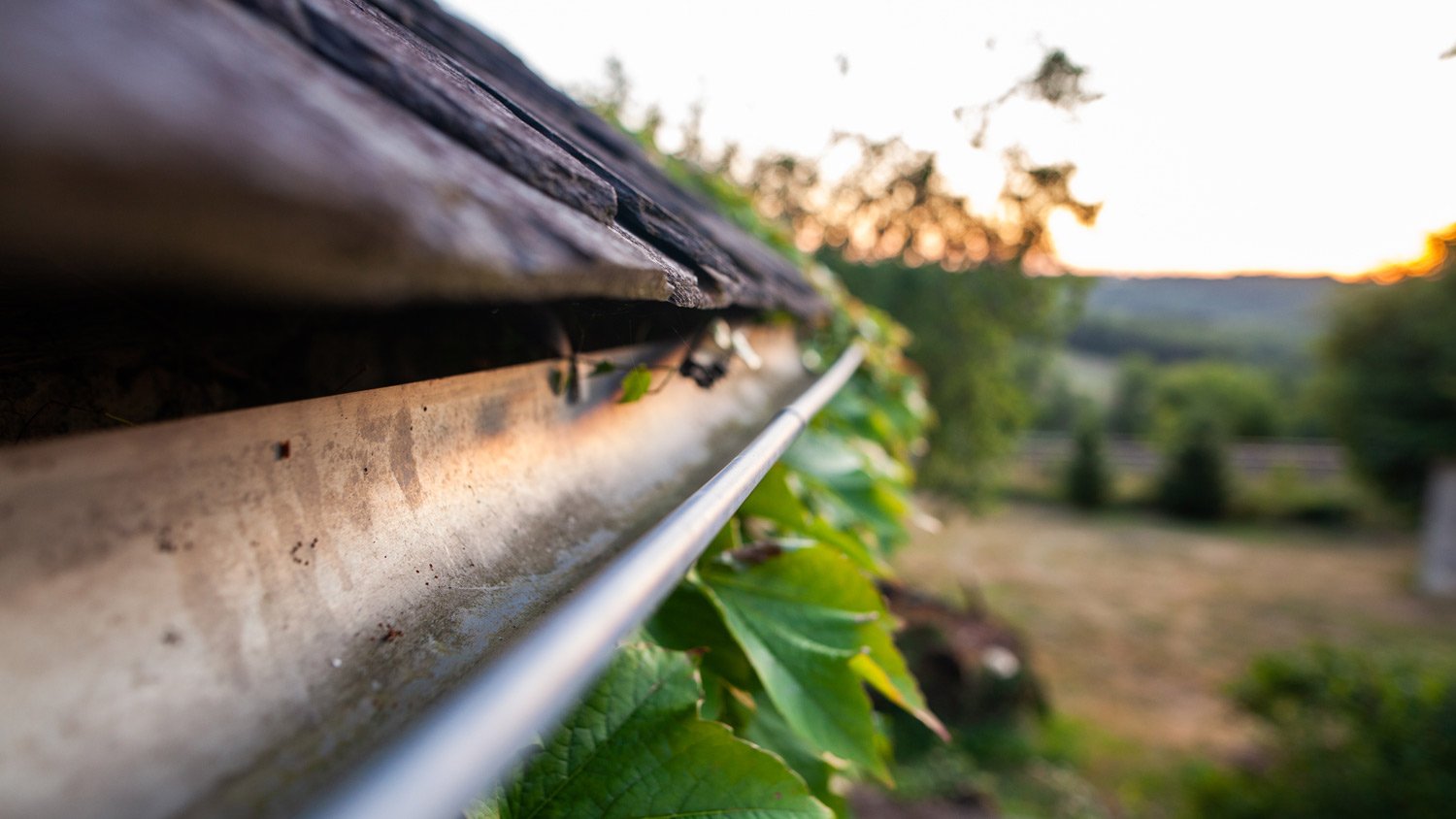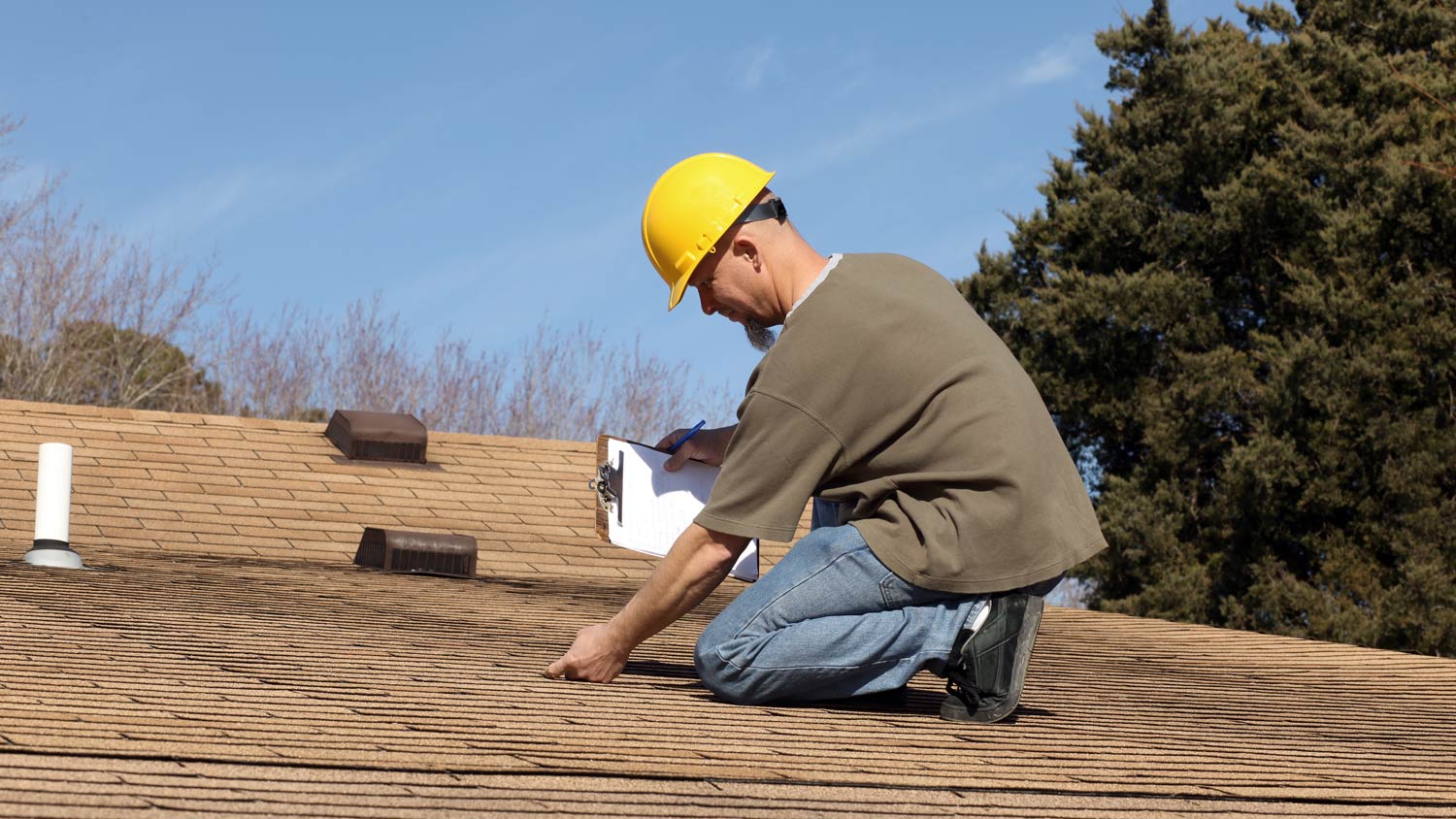What to Do After Hail Damages Your Roof
Get your roof right as rain


Start with a visual inspection of your roof to check for hail damage.
Check your roofs, gutters, and siding for any necessary repairs.
Get a professional roof inspection if you suspect damage.
A hailstorm can create significant damage to your property, including to your roof, siding, and gutters. Your roof is one of the most important parts of your home, so it is crucial to address any concerns that may arise immediately after a hailstorm. If you think you have a hail-damaged roof, you’ll want to develop a concrete plan of action for any potentially necessary repairs and, most importantly, keep your home safe and dry.
Steps to Follow If You Suspect Hail Has Damaged Your Roof
A nasty storm rolled through, and now you’re wondering if the hail caused any lasting damage. Here are seven simple steps to determine if anything is wrong and, if so, what you should do next.
1. Determine the Severity of the Hailstorm

Knowing how intense a hailstorm was will help give you a sense of any potential roof damage. Storms can pour down in a range of different hailstone sizes, from a dime size of less than 1/2 an inch up to a few inches in thickness—think the size of a golf ball or tennis ball, and sometimes even bigger. And, when combined with high winds, hailstorms have the potential to damage your roof considerably.
The bigger the hailstones are, the bigger the roof damage can be. If the hailstones are under half an inch, they may create some minor cosmetic damage to your roof, like small cracks, or result in small pieces of shingles going missing. If the storm has hailstones bigger than an inch and is combined with strong winds, these are the perfect conditions for serious roof damage.
If you are not present at the time, you can check your local weather channel to learn about the severity of any given hailstorm. Even small hailstorms probably warrant a quick look up at your roof. But, if you are at home while the hail is coming down, for your safety, it’s important to stay indoors until the storm passes.
2. Conduct a Visual Inspection of Your Roof for Hail Damage
Once the hailstorm is over, one of the easiest ways to determine any roof damage is to conduct a visual assessment from the ground. Look for loose and missing shingles, signs of roof discoloration, and wood exposure.
Use a pair of binoculars to examine your roof more closely. If your property has an attic, inspect it from the inside, checking for any signs of water leaks or sunlight exposure.
“Hail damage can be nearly impossible to see from the ground. If you do not know what you are looking for, it can even be difficult to see when you are up on the roof. I would highly recommend asking a roofing professional to check your roof if you had golf ball size or larger hail.”
— Ami Feller, Feller Roofing, New Braunfels, TX
3. Check Your Gutters, Metal Fascia, Roof Flashing, and Windows

Metal products, such as gutters, fascia, and roof flashing, offer an easy way to identify hail damage to your property since dents are easier to see on these types of materials. You can also check for holes or tears in the window screens as well as the plastic or vinyl glazing strip around the window glass. You may notice dents in the frame around the outside of the window, or dents may show up on wood shutters after a hailstorm. Hail that is bigger than 1 inch in diameter may crack window glass, as well.
In addition, if your gutters are clogged with shingle granules (crushed stones and other debris) and overflow when it rains, these are other signs of potential damage to your roof. It’s also wise to check for damage to your AC fins if your unit is outside and look for spatter marks on the AC, electric panels, and fencing.
4. Request a Roof Inspection

If a simple visual assessment from the ground shows signs of damage, it's time to get a local roofing contractor for an inspection. These professionals are experts in the field and can take a closer look at your roofing materials, chimney, roof flashing, and gutters. They’ll be able to determine the level of damage, if any, and make recommendations on the next steps.
On average, a professional roof inspection for hail damage will cost $75 to $800. Climbing up on a roof after a storm can be dangerous and requires extensive experience to do so safely. While you may be tempted to DIY to save money (and you can perform your own inspections on siding and windows), you should leave a roof inspection to the pros.
5. Inform Your Home Insurance Company
The sooner you notify your property insurance company of any roof hail damage, the better in case you need to submit a hail damage insurance claim. Most insurance companies require that you report storm damage within six to 24 months. Your insurance provider will perform their own assessment of the roof damage and take it from there.
Make sure to know what your home insurance policy covers, especially if you live in areas like Colorado, Nebraska, and Wyoming. According to the National Oceanic and Atmospheric Administration’s National Severe Storms Laboratory, in some parts of these states, it’s common to get as many as nine hailstorms a year.
When to Repair Roof Hail Damage
Your roof may not need repair if the hail damage is only cosmetic. Rather than make this assessment yourself, it’s best to hire a roof repair company near you to take a look before writing off the damage.
On the other hand, if the hail damage affects the structural integrity of your roof, getting it repaired is necessary. Without proper repairs, your roof may begin leaking, inevitably leading to more problems.
From water damage to mold to property damage, a leaky roof is bound to cause more expensive issues than simply fixing the roof from the get-go. Hail damage roof repair costs an average of $940 but can be as little as $20 or reach into the thousands for more extensive damage.
In the worst-case scenario, you may need to factor in roof replacement costs, which average $9,100. Your insurance may cover these costs, so contact them and check your policy.
Repairing Roof Hail Damage Yourself vs. Hiring a Pro
Repairing roof hail damage can be pricey when hiring an emergency roofing pro near you, so you may be tempted to DIY the repairs on your own. However, DIY roof repairs are best left to pros with extensive knowledge and experience working on roofs.
Roof repair entails working at dangerous heights, and without the proper safety background, you run the risk of severe injury.
While some homeowners might be okay patching small leaks or cleaning the gutter, structural damage from hail should be repaired by a roofing professional.
Frequently Asked Questions
Hail that is at least 1 inch in diameter will typically damage a roof and other property, including windows and vehicles. The extent of damage can be significantly worse, even with small-sized hail, if the wind is intense. Hail-resistant roof tiles, like slate or certain types of asphalt shingles, will better withstand hail impact, leaving you with little, if any, damage after a storm.
Metal roofs are more resistant to hail than other types of roof materials; however, hail can still damage a metal roof. The extent of the damage depends on the size of the hail and the severity of the hail storm. The type of damage a metal roof can get from hail includes dents, scratches, loose fasteners, leaks, and cracked paint.
Roof blistering and hail damage are different in their physical appearance. Blistering, often caused by inadequate ventilation, low-quality material, and improper installation, looks like large, irregular bubbles popping out of your roof. Meanwhile, hail damage is usually circular or oval dents entering your roof and often follows the same path as the hail storm.
The amount of hail damage that warrants a roof replacement depends on the size of the hail. In many cases, a roof replacement is needed if your roof gets hail that is 1 inch or larger in diameter. You may also need to replace a roof due to hail damage if you notice several dents in the shingles or there are seven to 10 hail impact marks within a 10x10 foot area on your roof.
Hail damage is bad for a roof because it can leave the roof vulnerable to the elements. Hail may leave more than dents or scratches behind. It can actually cause the shingles to crack, which means water can leak into your home from the roof. Hail can also wear down the granules on the shingles. Without these granules, the shingles are weaker and more vulnerable to the elements, particularly wind. If the hailstorm is accompanied by high winds, it may take your shingles with it.





- Roofers
- Metal Roofing
- Roof Repair
- Roof Inspection
- Vinyl Siding Repair Contractors
- Flat Roofing Companies
- Commercial Roofing
- Emergency Roofing Companies
- Leaky Roof Repair
- Metal Roof Repair
- Business Roof Repair
- Flat Roof Repair
- Tile Roof Repair
- Slate Roofers
- Rubber Roofers
- Roofing & Siding
- Metal Roof Installation
- Affordable Roofing
- Roof Sealing
- Attic Ventilation Contractors
- How Much Hail Damage Do You Need to Replace a Roof?
- Why Is Hail Damage Bad for a Roof?
- Is Hail Strong Enough to Damage a Metal Roof?
- What Size Hail Will Damage a Roof During a Storm?
- 8 Signs of Storm Damage to a Roof and What to Do About It
- 9 Warning Signs You Need a New Roof
- Should You Repair or Replace Your Roof?
- What to Do If Your Roof Has Storm Damage
- A Complete Guide to Dealing With Emergency Roof Repair
- Roof Inspection Guide: Everything You Should Know











